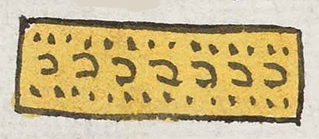Tlalcozauhtitlan (Mdz40r)
This compound glyph, representing the place name Tlalcozauhtitlan, has two visual components, tlalli (agricultural parcel) and cozahui (to turn yellow). The ligature (-ti-) and the locative (-tlan) are not represented visually, but perhaps the landscape provides a semantic locative. The tlalli has texturing with dots and sideways U-shapes or backwards C-shapes, but it does not have the usual segmentation.
Stephanie Wood
The yellow color of the parcel here replaces the more typical alternating orange and purple divisions that run across a strip of land. Yellow land recalls, perhaps, the dry season, when the green grasses turn golden or a parcel lies fallow. It is typical here that we look down on the parcel from a birdseye view.
Stephanie Wood
tlalcoçauhtitlā.pou
Tlalcozauhtitlan, pueblo
Stephanie Wood
c. 1541, but by 1553 at the latest
Stephanie Wood
nombres de lugares

tlal(li), land, https://nahuatl.wired-humanities.org/content/tlalli
cozahui, to turn yellow, https://nahuatl.wired-humanities.org/content/cozahuiya
-titlan (locative suffix), https://nahuatl.wired-humanities.org/content/titlan
-tlan (locative suffix), place, https://nahuatl.wired-humanities.org/content/tlan
Codex Mendoza, folio 40 recto, https://digital.bodleian.ox.ac.uk/objects/2fea788e-2aa2-4f08-b6d9-648c00..., image 90 of 188.
The Bodleian Libraries, University of Oxford, hold the original manuscript, the MS. Arch. Selden. A. 1. This image is published here under the UK Creative Commons, “Attribution-NonCommercial-ShareAlike 3.0 License” (CC-BY-NC-SA 3.0).

